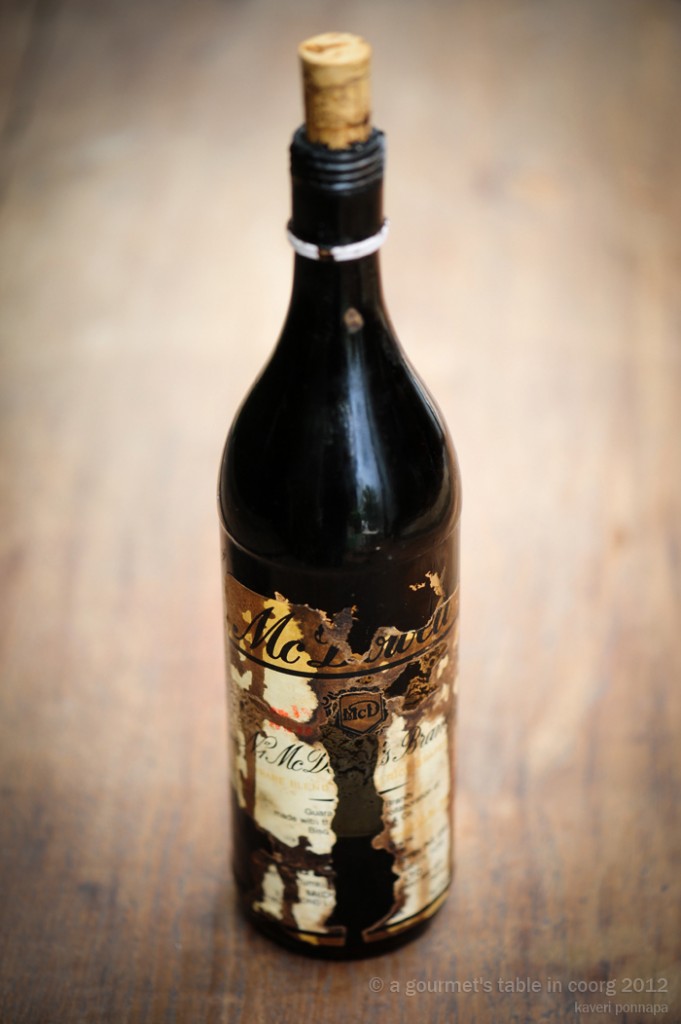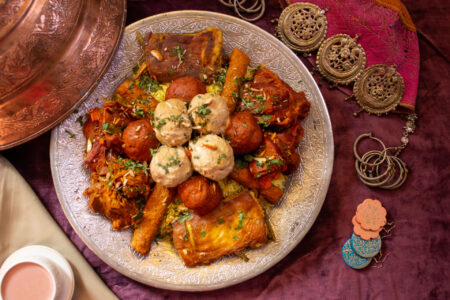Kachampuli : is an ingredient you will encounter frequently in many Coorg dishes. It is a dark, tart vinegar, which has been made in the region for centuries, and is indispensable in many preparations. Every Coorg kitchen has a couple of bottles, or more, of the vinegar stored away, and at one time most families- including my mother-in-law’s, from whom I have this recipe – made their own. The ripe fruits from the Garcinia gummi gutta tree are gathered and heaped up in winnowing fans or new baskets, and left outdoors to ferment and release their juices, which are collected in earthenware pots placed underneath. This juice is then gently boiled down, until it thickens, into a dark brown vinegar which can be stored indefinitely. With long storage, all its properties intensify – the vinegar just becomes denser, darker, more sour and sticky. The young vinegar is lighter in colour, pours easily, and you will need to use more of it for the required sourness.
During ancient times, the rajahs of Coorg issued orders to the local headmen to mark the panapuli trees, as they are known, that were ready to fruit. Tribals were directed to collect the fruit, carry it to the nearest village, where the vinegar was prepared. Some of the fruit was sun –dried, and packed into baskets made of reed and delivered to the Palace. My friend and fellow food writer, Marryam Reshii, summed it up beautifully when she likened kachampuli to the precious balsamic vinegar of Modena!
– kachampuli : which draws its name from the boiling process the fruit undergoes – is the signature flavour in all the classic Coorg dishes from pandi curry to chicken fry, and several in between. It is a souring and thickening agent, which can be used as a marinade. It is often added last to a curry that is already cooked, and simmered gently to thicken it, while adding a dash of that special flavour. It was also widely used in vegetarian dishes, although less so now, with the easy availability of other souring agents. A reasonable substitute is dark brown malt vinegar, although it will never give you the rich, dark colour of kachampuli. My preferred dark vinegar in the kitchen is E.F. Kolah’s brand established in 1885, the sugarcane juice matured without any additives, in wooden barrels in Navsari, Gujarat. Kokum, used extensively in Konkan cooking, and Kodampuli or fish tamarind from Kerala are fruits of the same botanical family. They are dried and used directly in cooking.
– tari : is used to make all the Coorg puttus is really washed, dried and hand pounded rice, each grain broken roughly into approximately three to four. Idly rava, easily available in all south Indian stores is a reasonable substitute. You can make your own tari at home by washing and drying the required quantity of rice, and then pulsing it in a mixer, taking care not to grind it to a powder.
– akki podi : is finely powdered rice, used to make rice rotis, and a batter for some fried sweets. It is available labeled ‘rice flour’ or ‘pathari podi’ in Manglorean and Kerala stores, and even Nilgiris Departmental Stores.
– paringe mollu : are bird’s eye chillis, Capsicum annum var. acuminatum, which grow in most kitchen gardens in Coorg. Their sharp, explosive flavours are prized in pickle making, and in roasted meats, especially pork.
– kaipuli : is Citrus avrantium, knobbly textured, the thick skinned bitter orange. They are made into a delicious, fresh raita with yoghurt; or an intense chutney, after the skins are roasted, charred and peeled in a wood fire. Kaipuli makes superb marmalade, and juice, and is also excellent squeezed directly onto fish and meat dishes for a citrus flavour. Freshly squeezed, sweetened kaipuli juice is a very refreshing drink, with a pleasing flavour.
– kartha masala : is a combination of dry roasted, ground spices that figures in many classic recipes and lends a special flavour to dishes such as pandi curry, meen curry and bimbale curry. The basic ingredients are cumin, mustard seeds, black peppercorns and fenugreek seeds roasted coffee-brown, and used in the curries. A few other spices may be used too, depending on the recipe.
You’re most welcome to share, but please give credit to the author and blog, as these are ORIGINAL FAMILY RECIPES. These articles and recipes have been printed and published by the author in several magazines and publications, and are copyrighted material
Image Credits: Nithin Sagi




